
e163 food additive
Understanding E163 The Natural Food Colorant
Food additives play a crucial role in the food industry, enhancing the appearance, flavor, and shelf life of various products. One such additive is E163, a natural coloring agent derived from plants. Known primarily as anthocyanins, E163 is commonly extracted from fruits, vegetables, and flowers, imparting vibrant colors ranging from red to purple.
The Source and Benefits of E163
E163 is predominantly sourced from various fruits such as berries (blueberries, blackberries, and raspberries), red cabbage, and grape skins. These natural pigments are part of a larger family of flavonoids, which are known for their antioxidant properties. The consumption of anthocyanin-rich foods is associated with several health benefits, including improved cardiovascular health, anti-inflammatory effects, and enhanced cognitive function.
The use of E163 in food products not only makes them visually appealing but also provides an opportunity to promote health-conscious choices among consumers. As more individuals become aware of the ingredients in their food, there is a growing preference for natural additives over synthetic ones. Thus, E163 aligns perfectly with this trend, offering both aesthetic and health benefits.
Applications of E163 in Food Industry
E163 is versatile in its applications across the food industry. It is primarily used to color beverages, confectioneries, dairy products, and baked goods. For instance, E163 brings vibrancy to fruit juices, ensuring they attract consumers with their alluring hues. In baked goods, it can enhance the color of frostings and icing, making these treats more appealing.
e163 food additive

In addition to being a natural colorant, E163 also serves functional roles in food products. It can act as a pH indicator, changing color based on the acidity of the environment. This property can be particularly beneficial in products that require specific color cues, such as yogurt or jellies that have varying flavors and acidity levels.
Safety and Regulations
One of the significant advantages of E163 is its classification as a safe food additive. Regulatory bodies, including the European Food Safety Authority (EFSA) and the Food and Drug Administration (FDA) in the United States, recognize E163 as safe for consumption. Studies have shown that anthocyanins are non-toxic and do not present health hazards when consumed in typical dietary amounts.
However, it is essential to note that the stability of E163 can be affected by factors such as pH and temperature. In acidic environments, anthocyanins can appear red, whereas, in neutral or alkaline conditions, they may shift towards blue or purple. This behavior necessitates careful formulation in food products to maintain the desired color throughout their shelf life.
Conclusion
In conclusion, E163 stands out as a natural food additive that not only enhances the visual appeal of products but also contributes potential health benefits. Its versatility and safety make it an attractive option for manufacturers looking to meet the growing consumer demand for natural ingredients. As the food industry continues to evolve towards more organic and less processed options, E163 is likely to play a significant role in shaping future food trends. Whether in your favorite fruit juice or a delicious cake, you can appreciate the vibrant colors and the natural sources of E163, knowing that it is both a feast for the eyes and a step towards healthier eating.
-
Buy High-Quality Trichloroisocyanuric Acid for Sale | TCCA 90% SupplierNewsAug.30,2025
-
Pure Sodium Dichloroisocyanurate Dihydrate | Powerful DisinfectantNewsAug.29,2025
-
Industrial Chemicals: Quality & Purity for Every IndustryNewsAug.28,2025
-
Nitrile Rubber Honoring Strict Production StandardsNewsAug.22,2025
-
Aspartame Ingredients Honoring Food Safety ValuesNewsAug.22,2025
-
Fertilizer for Balanced Plant NutritionNewsAug.22,2025
-
Cyanide Gold Processing with High Purity AdditivesNewsAug.22,2025
Hebei Tenger Chemical Technology Co., Ltd. focuses on the chemical industry and is committed to the export service of chemical raw materials.
-

view more DiethanolisopropanolamineIn the ever-growing field of chemical solutions, diethanolisopropanolamine (DEIPA) stands out as a versatile and important compound. Due to its unique chemical structure and properties, DEIPA is of interest to various industries including construction, personal care, and agriculture. -

view more TriisopropanolamineTriisopropanolamine (TIPA) alkanol amine substance, is a kind of alcohol amine compound with amino and alcohol hydroxyl, and because of its molecules contains both amino and hydroxyl. -

view more Tetramethyl Thiuram DisulfideTetramethyl thiuram disulfide, also known as TMTD, is a white to light-yellow powder with a distinct sulfur-like odor. It is soluble in organic solvents such as benzene, acetone, and ethyl acetate, making it highly versatile for use in different formulations. TMTD is known for its excellent vulcanization acceleration properties, which makes it a key ingredient in the production of rubber products. Additionally, it acts as an effective fungicide and bactericide, making it valuable in agricultural applications. Its high purity and stability ensure consistent performance, making it a preferred choice for manufacturers across various industries.





